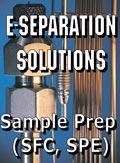The Global Laboratory Life Science and Analytical Instrument Industry
The laboratory life science and analytical instrument industry is comprised of a large, diverse group of organizations that manufacture and distribute their products worldwide. However, overall industry sales are concentrated among a small set of companies. Approximately 950 firms are included in the industry, but only about 100 companies have sales above $50 million.
The laboratory life science and analytical instrument industry is comprised of a large, diverse group of organizations that manufacture and distribute their products worldwide. However, overall industry sales are concentrated among a small set of companies. Approximately 950 firms are included in the industry, but only about 100 companies have sales above $50 million.
The instrument industry consists of over 60 individual instrument techniques, which are grouped into nine technology categories: separations, life science instrumentation, mass spectrometry, molecular spectroscopy, atomic spectroscopy, surface science techniques, materials characterization, lab automation, and general techniques.

2005 life science and analytical instrument industry
The global market for analytical instrumentation increased modestly from over $22 billion in 2000 to more than $30 billion in 2005. The last few years have been lackluster due to economic uncertainties, but the future already has filled industry participants with enthusiasm. The total analytical instrument market is projected to generate nearly $42 billion in annual revenues by 2010.
As the dynamics of the industry continue to change, vendors are taking advantage of the new opportunities. Technological improvements, new applications, and explosive growth in emerging geographies are providing a positive stimulus to the analytical instrument market. In particular, life science research and drug development continue to represent an increasingly prominent source of demand.
The top 50 companies accounted for over $22 billion in annual sales in 2005, representing more than 70% of the total instrument market. Many of these industry participants are broad-based suppliers looking to expand their market presence even further through mergers and acquisitions.
The continued growth in North America, Europe, and Japan has been supported by the continued demand from pharmaceutical, biotechnology, government, and academic institutions. These regions therefore account for nearly all of the demand for the latest, most advanced, and most expensive instruments, which are used in the development of medical diagnostic tools, disease analysis, and drug development. China and other Asia Pacific countries have become increasingly involved in the manufacturing of pharmaceuticals and electronic products.
The foregoing data was extracted and adapted from Instrument Business Outlook, an SDi publication, and SDi's Global Assessment Report, 9th Edition. For more information, contact Glenn Cudiamat, VP of Research Services, Strategic Directions International, Inc., 6242 Westchester Parkway, Suite 100, Los Angeles, CA 90045, tel. (310) 641-4982, fax (310) 641-8851, e-mail: cudiamat@strategic-directions.com
Detailed Glycosylation Analysis of Therapeutic Enzymes Utilizing Comprehensive 2D-LC–MS
January 3rd 2025In this article, the use of comprehensive two-dimensional liquid chromatography (LC×LC) coupled to mass spectrometry (MS) for characterizing glycosylation of therapeutic enzymes is presented.
